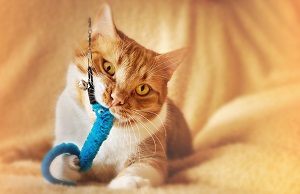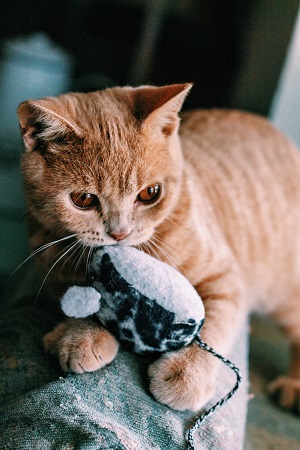Cat kicker toys are designed to provide hours of engaging play for our feline companions. However, as responsible pet owners, it’s crucial to be aware of potential hazards associated with these toys, particularly the risk of cats ingesting small parts. Ingestion of small toy components can lead to choking or digestive issues.

Practical Measures
This article explores practical measures to prevent cats from ingesting small parts of cat kicker toys, ensuring their safety and well-being.
1. Choose Safe Cat Kicker Toys
Select cat kicker toys with minimal or securely attached accessories. Opt for toys that don’t have small parts that could easily break off, posing a choking hazard. Inspect the toys before purchasing and avoid those with loose or detachable components.
2. Size Matters
Choose cat kicker toys that are appropriately sized for your cat. Toys that are too small may be more likely to be ingested accidentally.
Larger toys are not only safer but also more enjoyable for cats to interact with.
3. Supervise Playtime
During play sessions, especially with new toys, supervise your cat closely. This allows you to observe how your cat interacts with the toy and whether any parts are at risk of coming loose.
4. Regular Inspections
Frequently inspect the cat kicker toys for signs of wear and tear. Small parts, such as buttons, bells, or feathers, can become loose over time. If you notice any loose parts, repair or replace the toy immediately.
5. Remove Hazardous Components
If you have a toy that contains small parts, consider removing those components before giving the toy to your cat. This ensures that even if parts come loose, they won’t pose a risk to your cat’s health.
6. Use Sturdy Materials
Choose cat kicker toys made from durable materials that are less likely to break or come apart. Sturdy stitching and quality construction can significantly reduce the risk of small parts becoming loose.
7. Rotate Toys
Regularly rotate your cat’s toys to keep their playtime engaging and novel. New toys are less likely to have loose parts, reducing the risk of accidental ingestion.
8. Train with Positive Reinforcement
Teach your cat to play with the toy appropriately by using positive reinforcement. Reward them with treats or praise when they engage with the toy without trying to chew or ingest it.
9. Store Toys Safely
When playtime is over, store the cat kicker toys in a secure container or designated storage area. This prevents cats from accessing the toys unsupervised, reducing the chances of small parts being ingested.
10. Seek Veterinary Advice
If you suspect your cat has ingested a small part of a toy, seek veterinary attention immediately. Prompt action can prevent potential complications and ensure your cat’s safety.

Conclusion
Responsible cat ownership includes taking precautions to prevent the ingestion of small parts from cat kicker toys. By choosing safe toys, supervising playtime, and maintaining a vigilant approach, you can create a secure and enjoyable play environment for your feline friend.
Keeping your cat’s well-being at the forefront will ensure that playtime remains a positive and enriching experience.
 Belinda
Belinda